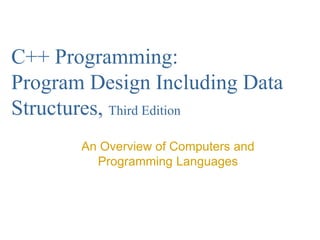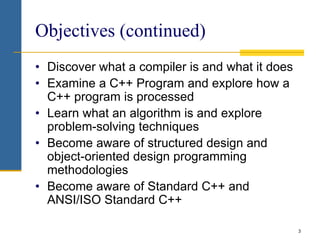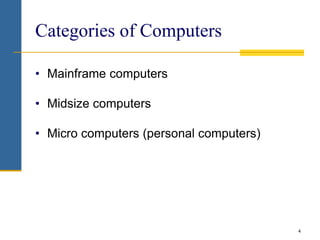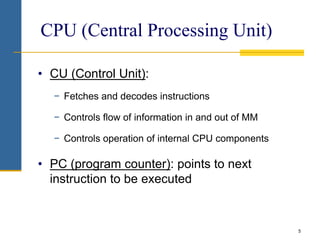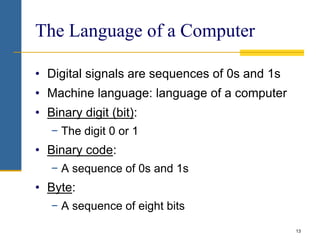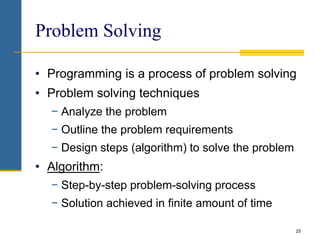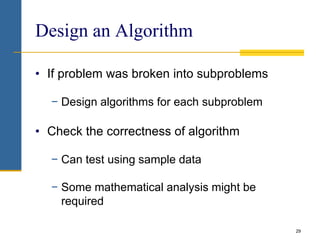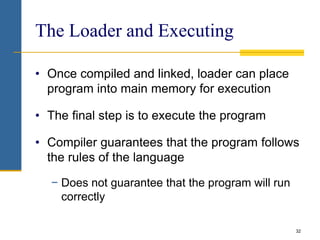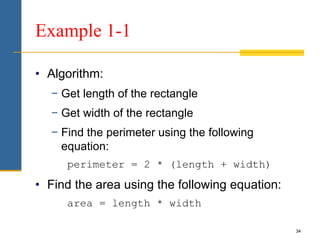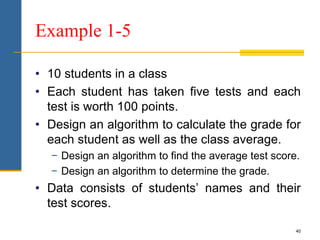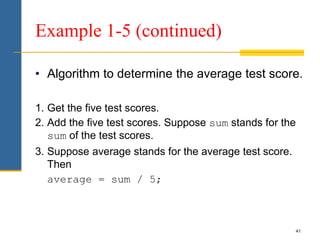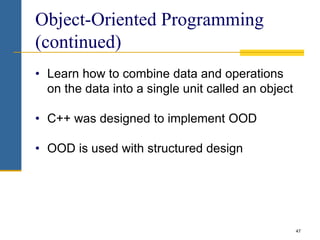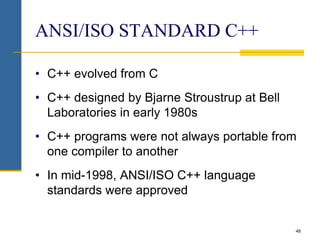C++ programming program design including data structures
- 1. C++ Programming: Program Design Including Data Structures, Third Edition An Overview of Computers and Programming Languages
- 2. 2 Objectives In this chapter you will: • Learn about different types of computers • Explore the hardware and software components of a computer system • Learn about the language of a computer • Learn about the evolution of programming languages • Examine high-level programming languages
- 3. 3 Objectives (continued) • Discover what a compiler is and what it does • Examine a C++ Program and explore how a C++ program is processed • Learn what an algorithm is and explore problem-solving techniques • Become aware of structured design and object-oriented design programming methodologies • Become aware of Standard C++ and ANSI/ISO Standard C++
- 4. 4 Categories of Computers • Mainframe computers • Midsize computers • Micro computers (personal computers)
- 5. 5 CPU (Central Processing Unit) • CU (Control Unit): − Fetches and decodes instructions − Controls flow of information in and out of MM − Controls operation of internal CPU components • PC (program counter): points to next instruction to be executed
- 6. 6 CPU (Central Processing Unit) (continued) • IR (instruction register): holds instruction currently being executed • ALU (arithmetic logic unit): carries out all arithmetic and logical operations
- 8. 8 Main Memory • Directly connected to the CPU • All programs must be loaded into main memory before they can be executed • All data must be brought into main memory before it can be manipulated • When computer power is turned off, everything in main memory is lost
- 10. 10 Secondary Storage • Secondary storage: Device that stores information permanently • Examples of secondary storage: − Hard disks − Floppy disks − Zip disks − CD-ROMs − Tapes − Flash drives
- 11. 11 Input/Output Devices • Input devices feed data and programs into computers. They include: − Keyboard − Mouse − Secondary storage • Output devices display results. They include: − Monitor − Printer − Secondary storage
- 12. 12 Software • Software: Programs that do specific tasks • System programs take control of the computer, such as an operating system • Application programs perform a specific task − Word processors − Spreadsheets − Games
- 13. 13 The Language of a Computer • Digital signals are sequences of 0s and 1s • Machine language: language of a computer • Binary digit (bit): − The digit 0 or 1 • Binary code: − A sequence of 0s and 1s • Byte: − A sequence of eight bits
- 15. 15 Coding Schemes • ASCII (American Standard Code for Information Interchange) − 128 characters − A is encoded as 1000001 (66th character) − 3 is encoded as 0110011
- 16. 16 Coding Schemes (continued) • EBCDIC − Used by IBM − 256 characters • Unicode − 65536 characters − Two bytes are needed to store a character
- 17. 17 Programming Language Evolution • Early computers were programmed in machine language • To calculate wages = rates * hours in machine language: 100100 010001 //Load 100110 010010 //Multiply 100010 010011 //Store
- 18. 18 Assembly Language • Assembly language instructions are mnemonic • Assembler: translates a program written in assembly language into machine language
- 19. • Using the assembly language instructions, the equation wages = rates • hours can be written as follows: LOAD rate MULT hour STOR wages
- 20. 20 High-Level Languages • High-level languages include Basic, FORTRAN, COBOL, Pascal, C++, C, and Java • Compiler: translates a program written in a high-level language machine language • The equation wages = rate • hours can be written in C++ as: wages = rate * hours;
- 21. 21 A C++ Program #include <iostream> using namespace std; int main() { cout << "My first C++ program." << endl; cout << "The sum of 2 and 3 = " << 5 << endl; cout << "7 + 8 = " << 7 + 8 << endl; return 0; } Sample Run: My first C++ program. The sum of 2 and 3 = 5 7 + 8 = 15
- 22. 22 Processing a Program • To execute a program written in a high-level language such as C++ − Use an editor to create a source program in C++ − In a C++ program, statements that begin with the symbol # are called preprocessor directives. These statements are processed by a program called preprocessor. − Use the compiler to • Check that the program obeys the rules • Translate into machine language (object program) − Software Development Kit (SDK) may be used to create a program
- 23. 23 Processing a Program (continued) − Linker: Combines object program with other programs provided by the SDK to create executable code − Loader: • Loads executable program into main memory − The last step is to execute the program
- 25. 25 Problem Solving • Programming is a process of problem solving • Problem solving techniques − Analyze the problem − Outline the problem requirements − Design steps (algorithm) to solve the problem • Algorithm: − Step-by-step problem-solving process − Solution achieved in finite amount of time
- 26. 26 Problem Solving Process • Step 1 - Analyze the problem − Outline the problem and its requirements − Design steps (algorithm) to solve the problem • Step 2 - Implement the algorithm − Implement the algorithm in code − Verify that the algorithm works • Step 3 - Maintenance − Use and modify the program if the problem domain changes
- 28. 28 Analyze the Problem • Thoroughly understand the problem • Understand problem requirements − Does program require user interaction? − Does program manipulate data? − What is the output? • If the problem is complex, divide it into subproblems − Analyze each subproblem as above
- 29. 29 Design an Algorithm • If problem was broken into subproblems − Design algorithms for each subproblem • Check the correctness of algorithm − Can test using sample data − Some mathematical analysis might be required
- 30. 30 Write the Code • Once the algorithm is designed and correctness verified − Write the equivalent code in high-level language • Enter the program using text editor
- 31. 31 Compiling and Linking • Run code through compiler • If compiler generates errors − Look at code and remove errors − Run code again through compiler • If there are no syntax errors − Compiler generates equivalent machine code • Linker links machine code with system resources
- 32. 32 The Loader and Executing • Once compiled and linked, loader can place program into main memory for execution • The final step is to execute the program • Compiler guarantees that the program follows the rules of the language − Does not guarantee that the program will run correctly
- 33. 33 Example 1-1 - Rectangle • Design an algorithm to find the perimeter and area of a rectangle • The perimeter and area of the rectangle are given by the following formulas: perimeter = 2 * (length + width) area = length * width
- 34. 34 Example 1-1 • Algorithm: − Get length of the rectangle − Get width of the rectangle − Find the perimeter using the following equation: perimeter = 2 * (length + width) • Find the area using the following equation: area = length * width
- 35. 35 Example 1-3 • Every salesperson has a base salary • Salesperson receives $10 bonus at the end of the month for each year worked if he or she has been with the store for five or less years • The bonus is $20 for each year that he or she has worked there if over 5 years
- 36. 36 Example 1-3 (continued) • Additional bonuses are as follows: − If total sales for the month are $5,000- $10,000, he or she receives a 3% commission on the sale − If total sales for the month are at least $10,000, he or she receives a 6% commission on the sale
- 37. 37 Example 1-3 (continued) • Get baseSalary • Get noOfServiceYears • Calculate bonus using the following formula: if (noOfServiceYears is less than or equal to five) bonus = 10 * noOfServiceYears otherwise bonus = 20 * noOfServiceYears • Get totalSale
- 38. 38 Example 1-3 (continued) • Calculate additionalBonus as follows: if (totalSale is less than 5000) additionalBonus = 0 otherwise if (totalSale is greater than or equal to 5000 and totalSale is less than 10000) additionalBonus = totalSale · (0.03) otherwise additionalBonus = totalSale · (0.06)
- 39. 39 Example 1-3 (continued) • Calculate payCheck using the equation payCheck = baseSalary + bonus + additionalBonus
- 40. 40 Example 1-5 • 10 students in a class • Each student has taken five tests and each test is worth 100 points. • Design an algorithm to calculate the grade for each student as well as the class average. − Design an algorithm to find the average test score. − Design an algorithm to determine the grade. • Data consists of students’ names and their test scores.
- 41. 41 Example 1-5 (continued) • Algorithm to determine the average test score. 1. Get the five test scores. 2. Add the five test scores. Suppose sum stands for the sum of the test scores. 3. Suppose average stands for the average test score. Then average = sum / 5;
- 42. 42 Example 1-5 (continued) • Algorithm to determine the grade. if average is greater than or equal to 90 grade = A otherwise if average is greater than or equal to 80 and less than 90 grade = B otherwise if average is greater than or equal to 70 and less than 80 grade = C otherwise if average is greater than or equal to 60 and less than 70 grade = D otherwise grade = F
- 43. 43 Example 1-5 (continued) • Main algorithm is as follows: 1. totalAverage = 0; 2. Repeat the following steps for each student in the class. a. Get student’s name. b. Use the algorithm as discussed above to find the average test score. c. Use the algorithm as discussed above to find the grade d. Update totalAverage by adding current student’s average test score. 3. Determine the class average as follows: classAverage = totalAverage / 10
- 44. 44 Structured Programming • Structured design: − Dividing a problem into smaller subproblems • Structured programming − Implementing a structured design • The structured design approach is also called − Top-down design − Stepwise refinement − Modular programming
- 45. 45 Object-Oriented Programming • Identify components called objects • Specify relevant data and possible operations to be performed on that data • Each object consists of data and operations on that data • An object combines data and operations on the data into a single unit
- 46. 46 Object-Oriented Programming (continued) • A programming language that implements OOD is called an object-oriented programming (OOP) language • Learn how to represent data in computer memory, how to manipulate data, and how to implement operations • Write algorithms and implement them in a programming language
- 47. 47 Object-Oriented Programming (continued) • Learn how to combine data and operations on the data into a single unit called an object • C++ was designed to implement OOD • OOD is used with structured design
- 48. 48 ANSI/ISO STANDARD C++ • C++ evolved from C • C++ designed by Bjarne Stroustrup at Bell Laboratories in early 1980s • C++ programs were not always portable from one compiler to another • In mid-1998, ANSI/ISO C++ language standards were approved
- 49. 49 Summary • Computer: an electronic device that can perform arithmetic and logical operations • Computer system has hardware and software • Central processing unit (CPU): brain • Primary storage (MM) is volatile; secondary storage (e.g., disk) is permanent • Operating system monitors the overall activity of the computer and provides services
- 50. 50 Summary (continued) • Various kinds of languages, such as machine language, assembly, high-level • Algorithm: step-by-step problem-solving process; solution in finite amount of time • The problem-solving process has three steps: 1. Analyze problem and design an algorithm 2. Implement the algorithm in code 3. Maintain the program
- 51. 51 Summary (continued) • Structured design: − Problem is divided into small subproblems − Each subproblem is solved − Combine solutions to all subproblems • Object-oriented design (OOD): a program is a collection of interacting objects • Object: data and operations on those data

